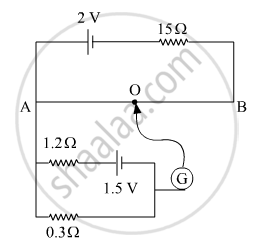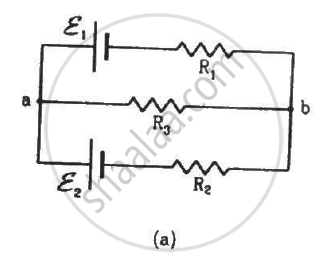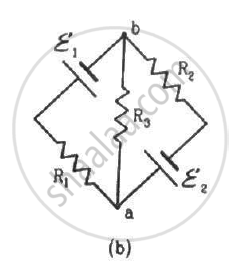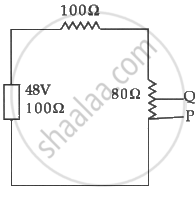Advertisements
Advertisements
प्रश्न
The current in a conductor and the potential difference across its ends are measured by an ammeter and a voltmeter. The meters draw negligible currents. The ammeter is accurate but the voltmeter has a zero error (that is, it does not read zero when no potential difference is applied). Calculate the zero error if the readings for two different conditions are 1.75 A, 14.4 V and 2.75 A, 22.4 V.
उत्तर
Let the magnitude of zero error in the voltmeter reading be V.
We need to subtract the zero error from the readings obtained under the two given conditions to obtain the true value of potential difference.
Under both the conditions ,the resistance of the wire will not change.
\[\Rightarrow R_1 = R_2 \]
\[ \Rightarrow \frac{V_1}{I_1} = \frac{V_2}{I_2}\]
\[\frac{I_1 R}{I_2 R} = \frac{V_1}{V_2}\]
\[ \Rightarrow \frac{1 . 75}{2 . 75} = \frac{14 . 4 - V}{22 . 4 - V}\]
\[ \Rightarrow \frac{0 . 35}{0 . 55} = \frac{14 . 4 - V}{22 . 4 - V}\]
\[ \Rightarrow \frac{7}{11} = \frac{14 . 4 - V}{22 . 4 - V}\]
\[ \Rightarrow 7 \times \left( 22 . 4 - V \right) = 11\left( 14 . 4 - V \right)\]
\[ \Rightarrow 156 . 8 - 7V = 158 . 4 - 11V\]
\[ \Rightarrow \left( 7 - 11 \right)V = 156 . 8 - 158 . 4\]
\[ \Rightarrow - 4V = - 1 . 6\]
\[ \Rightarrow V = 0 . 4 V\]
Magnitude of zero error, V = 0.4 V, which can either be positive or negative. Positive or negative zero error just indicates that the needle of the voltmeter is to the right or left of the zero marked on the device if zero voltage is applied across the voltmeter.
APPEARS IN
संबंधित प्रश्न
In the following potentiometer circuit, AB is a uniform wire of length 1 m and resistance 10 Ω. Calculate the potential gradient along the wire and balance length AO (= l).

When 5 V potential difference is applied across a wire of length 0.1 m, the drift speed of electrons is 2.5 x 10-4 m/s. If the electron density in the wire is 8 x 1028 m-3, calculate the resistivity of the material of the wire.
Why are Si and GaAs preferred materials for solar cells?
Why is potentiometer preferred over a voltmeter for comparison of emf. of cells?
The emf of a cell is always greater than its terminal voltage. Why? Give reason.
The potential difference between the terminals of a battery of emf 6.0 V and internal resistance 1 Ω drops to 5.8 V when connected across an external resistor. Find the resistance of the external resistor.
Find the potential difference Va – Vb in the circuits shown in the figure.


In the circuit shown in the figure, ε1 = 3 V, ε2 = 2 V, εa = 1 V and r1 = r2 = r3 = 1Ω. Find the potential difference between the points A and B and the current through each branch.

A voltmeter of resistance 400 Ω is used to measure the potential difference across the 100 Ω resistor in the circuit shown in the figure. (a) What will be the reading of the voltmeter? (b) What was the potential difference across 100 Ω before the voltmeter was connected?

A voltmeter consists of a 25 Ω coil connected in series with a 575 Ω resistor. The coil takes 10 mA for full-scale deflection. What maximum potential difference can be measured by this voltmeter?
If a constant potential difference is applied across a bulb, the current slightly decreases as time passes and then becomes constant. Explain.
In the circuit in figure the potential difference across P and Q will be nearest to

Two sources of equal e.m.f are connected to an external resistance R in series. The internal resistance of the two sources are R1 and R2 (R2 > R1) If the potential difference across the source having internal. resistance R2 is zero, then ______.
